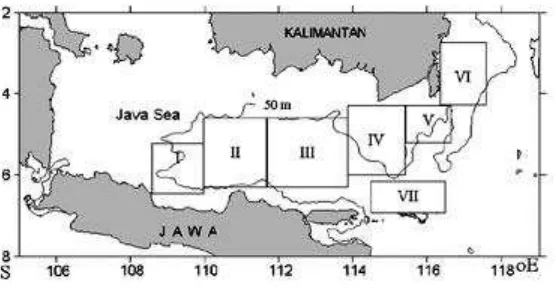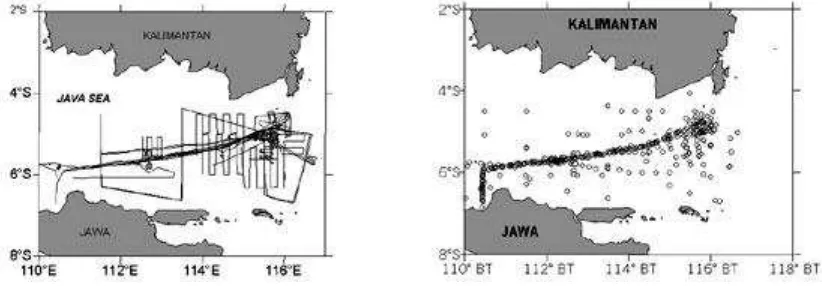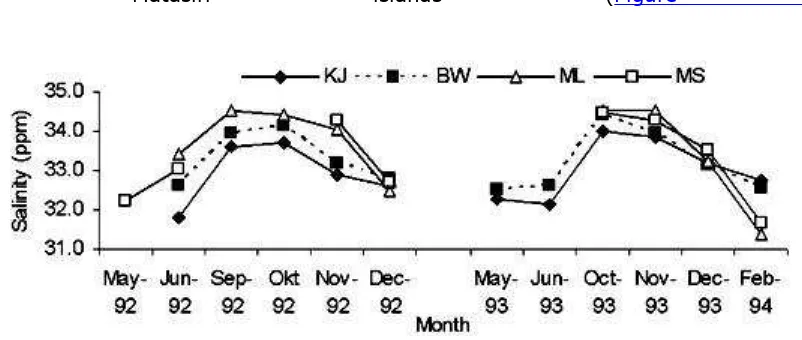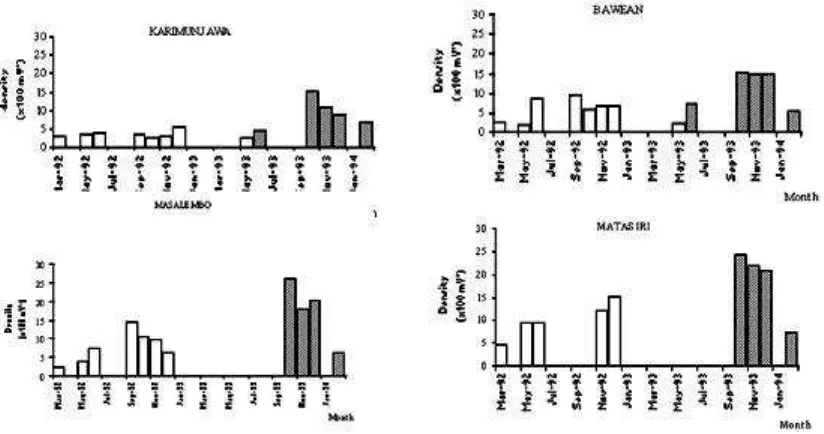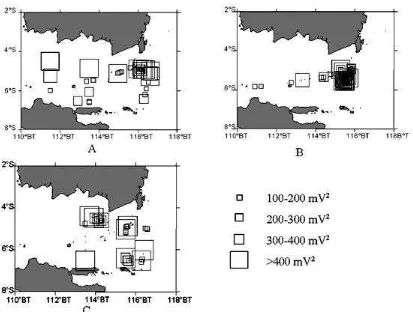Fish Stock Assessment Using Marine Acoustics
Detection And Oceanographical Characteristics In
Java Sea
Bonar P. Pasaribu 1, Djisman Manurung 1 & Duto Nugroho 2
1 Faculty of Fishery and Marine Sciences, Bogor Agricultural University. Jl. Rasamala, Darmaga Bogor, Indonesia. e-mail: [email protected]
2 Research Center of Capture Fisheries, Agency of Marine and Fisheries Research. Jl. Pasir Putih I, Ancol Timur Jakarta 14430. Indonesia
ABSTRACT
Study on the movements of pelagic fish as a benchmark of pelagic fish stock assessments were investigated by using marine acoustics detection and oceanographical characteristics. Several surveys during 1992 to1994 using a dual-beam BioSonics 120 kHz echo-sounder installed on R/V Bawal Putih (192 GT) were carried out in the middle part of Java Sea.
The objective was to verify the importance of seasonal shifting on fish abundance under strong influence of environmental changes. Data were systematically stored using Ines-Movies acquisition and processing system along isobaths 50m to100m. A depth layer was adjusted under 10m stratifications. Descriptions on environmental frame were done through measurements of temperature and salinity by using Seabirds CTD profiler.
The result shows higher saline water above 34 ppm is stronger influenced on the east and central of Java Sea during south-east monsoon (September to October 1992 and 1993). This condition is strongly related to the occurrence of higher fish density. The vertical and horizontal distribution of fish density shows that several group of fish populations seasonally occupied in the area. These observations clarified that coldwater intrusion from the Flores Sea and Makassar Strait play an important role in the west-eastward movements of Java Sea pelagic fish stocks.
INTRODUCTION
The use of marine acoustics in fisheries science in Indonesia has been carried out since early 1970's. Several sub areas were covered ever since starting with a single beam, single beam with echo integrator in the period of 1970-1990. Improvement on acoustics system also followed by using the dual beam echo integration system in the year of 1990-1995 and split beam acquisition system also being used since 1995 up to now.
being priority to carried out to support a real time data on estimation and distribution mainly to the small pelagic fish resources. Huge areas of marine waters in Indonesia become an opportunity to apply the marine acoustics but limited platform available became an obstacle to its development. A regular and repeated survey in a certain fishing area is not available due to technical and non technical constraints. The information to explain the dynamics of small pelagic fish stocks is available for the Java Sea during 1992 to 1994 under the collaboration of Indonesia-France through ORSTOM/EEC-AARD Java Sea small pelagic fisheries assessment project. Result of the cruises is presented in this paper.
The continental shelf of the Java Sea is estimated at 442 000 Km (Durand and Petit, 1995), with an average depth of 40 m. The environmental conditions controlled by a monsoonal cycle. Previous studies on the state of exploitation by seiners since 1976 showed that the fishing operations take place with aggregation in areas depending of the season (Nurhakim et al., 1987; Boely, Potier and Sadhotomo, 1992; Potier and Sadhotomo, 1995; Sadhotomo 1998 and Nugroho 2004). To supply information on the importance of the stock and its availability, the estimation of density by acoustics and its related aspects were applied into a frame work as a scientific tool for fish stock assessment for small pelagic fish resources in Indonesia.
The objectives of this research were carrying out descriptive stages of the phenomena permitting the answer elementary questions as follows: (1) Where are the more productive zones and what are their limits, (2) What is the importance of seasonal shifting under environmental influences? And, (3) Which species are these stocks composed of?
MATERIAL AND METHODS
Among the whole of 15 cruises that were available, it was decided to select cruises covering the most important area of the Java Sea. Data were collected aboard stern trawler R/V Bawal Putih 1 with several acoustic surveys carried out within the year of 1992 to1994. The echo integration was obtained by means of a dual beam 120 KHz echo sounder connected to an interface INES MOVIES, for digitalizing, display and echo integration of the signal.
As it is difficult to attribute a criterion of "pelagic or demersal" to the shoals close to the bottom, only the ones situated at more than 5 m from the bottom were taken into account in this study. We selected also the shoals giving a reverberation level more than 50 mV. As the monofrequency systems are unable to discriminate the species, these shoals can not be related to particular species; nevertheless as Gerlotto (1993) points out, we may consider that aggregations are referred to species having momentaneously the same "acoustical behaviour". Control systems of the instruments were as follows:
Frequency : 120 KHz Pulse
The environmental profiles were obtained by vertical measurements of temperature and salinity using Seabird CTD. The acoustics tracks, and its oceanographic stations were shown in Figure 2.
Figure 2. The acoustics tracks (left) and its oceanographic stations (right)
RESULTS
The small pelagic fisheries
lately landed mainly by the purse seiners. The highest catch dominated by scads (Decapterus spp.), jack mackerel (Rastrelliger spp.) and sardines (Sardinella spp.).
Effort analysis based on fisheries statistical data of Pekalongan (central Java) within a period of 1976 to 2000, as the main fishing base of purse seine fleets, showed that total catch of pelagic fishes tends to increase proportionally with number of boats (Figure 3).
Figure 3. The annual changes of number of purse seiner and total catches during a period of 1976 to 2000.
The purse seine fishery in the Asian tropical waters characterized by fish aggregating device called as "rumpon" to concentrate of small pelagic fish. Since 1971 the fishing ground were extended to the eastern part of the Java Sea with improvements of tactics and strategies which always shifting according to the environmental changes. Catch analysis of scads according to the fishing grounds around Bawean, Masalembo, Matasiri and Kangean islands showed that the successful fishing occurred during a period of high salinity (34%) (Potier and Sadhotomo, 1995; Sadhotomo, 1998). The highest catch during that period landed from Masalembo island fishing ground (Figure 19), this phenomenon correspond to the environmental conditions showed in Figure 21 and 22 which clearly explained that the shifting of east-west water masses affected the productivity of small pelagic fish in such area. The monthly changes of catches by dominant species by fishing grounds were shown in Figure 4.
The average catch rates around Masalembo islands clearly shows a seasonal cycles related to the monsoonal changes. Catch rates (ton/day of fishing) tend to high on August to November, with high salinity and lower temperature then decrease on December to July with high temperature and low salinity (Figure 5). Particular condition occurred on January to April 1992 with values of catch rates of 1.5 to 2.5 ton/day.
Figure 5. Monthly changes of catch rates (ton/day) of 5 main species of small pelagic around Masalembo fishing ground
The waters in the eastern part of the java sea are the Tran boundary areas which area influenced by the oceanic characteristics of Makassar Strait and Flores Sea waters and the condition varied according to the monsoonal changes. Observation during the year of 1992 to 1994 showed that sea surface temperature reach the maximum at around 30oC during
the Northwest or wet monsoon on December 1993 at stations close to Matasiri island then decrease to 28.5 oC on February 1994. Minimum value of 28oC occurred during the late of
south east or dry monsoon on September to October 1993 (Figure 6).
Figure 6. Monthly changes of sea surface temperature (°C) at the waters Karimun Jawa (KJ), Bawean (BW), Masalembo (ML) and Matasiri (MS) islands.
and Matasiri islands (Figure 7).
Figure 7. Monthly changes of sea surface salinity (ppm) at the waters around Karimun Jawa (KJ), Bawean (BW), Masalembo (ML) and Matasiri (MS) islands.
Specific measurements at around Masalembo island waters (Figure 8) showed that the sea surface temperature tend to high (29° C) during periods of May, November and December 1992 also on June, November and December 1993 (Figure 8).
Figure 8. Monthly changes of sea surface temperature and salinity around Masalembo islands, 5°30' S- 115° BT.
The entrance of high salinity 34 ppm showed that the waters masses moved from the eastern part (Makassar Strait and Flores Sea) to the west (middle part of the Java sea). These oceanographical changes were strongly influenced by the semi-reverse (more than 90°) annual wind directions and its current pattern (During, 1970; Fieux, 1987). These phenomenon categorized as the mixed area determined by the ocean atmospheric interaction parameters (Pedelaborde, 1965 videSadhotomo and Durand, 1997).
from several the big rivers during a rainy season. The lowest maximum-minimum surface salinity occurred on May 1992 (32-32.5°/oo) and the highest on October 1993 (33.6-34.5°/oo). Contours from two large coverage areas on October 1993 and February 1994 showed the shifting of space-temporal surface water masses which in general appropriate with previous pattern stated by Wirtky (1961). Figure 9 and 10 shows the representative spatial seasonal contour of temperature and salinity in the Java Sea.
Figure 9. Contour of surface temperature (°C) on October 1993 (left) and February 1994 (right).
Figure 10. Contour of surface salinity (ppm) during October 1993 (left) and February 1994 (right).
THE ESTIMATE DENSITY
Figure 11. The mean monthly density (mV) by fishing grounds.
The density distribution by fishing ground indicated that the highest density occurred during south-east monsoon of September till December then followed by lesser density at the beginning of the year on north-west monsoon till first inter monsoon on June (Figure 11). Higher density during north west monsoon always found in the eastern part of the area which means the small pelagic fish stock exist in the area for the whole year.
THE FISH SCHOOLS
Figure 12. Geographical distributions and its estimate density of fish schools (mV2) found during acoustics observations. (A: October 1993; B: December 1993 and C: February 1994).
Longitudinal movements of the schools to the east could be as a result of salinity gradually decrement due to fresh water discharge with lower salinity (see Figure 9 and 10) which generates heterogeneous condition of the water body. These conditions presume a significant role to the oceanic species such as scads (Decapterus macrosoma) and jack mackerel (Rastrelliger kanagurta) tend to migrate to the east associated with high salinity waters. Study on the catch data of purse seine fleets operated in the eastern part of the area, Sadhotomo and Potier (1995) and Potier (1998), showed that there are 3 different groups of pelagic fishes i.e. : oceanic groups such as scads (D. macrosoma), spotted sardines (Ambligaster sirm) and jack mackerel (R. kanagurta), a group of neritic and coastal belong to the species of coastal scads (D. russelli), big eye scads (Selar crumenopthalmus) and sardines (Sardinella gibbossa).
Seasonal changes of environmental characteristics in the Java Sea has been clearly explain by Wyrtki (1958) and Sadhotomo and Durand (1997) which the seasonal changes were illustrated by the temperature and salinity profiles also different wind and current directions during two main seasons south east and north west monsoon.
CONCLUSIONS
3000 mV/nm2 and minimum value of 200-400 mV/nm2 . Seasonal temperature and salinity profiles clearly showed as indicators of seasonal changes with different water characteristics occurred in the Java Sea. Minimum sea surface temperature 28°C found on late south east monsoon 1993 and the maximum of 30° C on northwest monsoon December 1993. Highest sea surface salinity of 34.5 °/oo found on September 1992 and October 1993, the minimum of 31.5 °/oo found on June 1992 and 31.0 °/oo on February 1994. Combination of marine acoustics and fisheries in the tropical waters of the Java Sea played a significant role and should be repeated after more than 10 years lack of recent information. The contribution of satellite remote sensing to detect a larger area of productivity could play as a gathering techniques to support the off shore pelagic fish stock assessment in near further research of marine acoustics techniques. These result should be treated as a milestone to the fleet management and its planning and controlling of recruitment of fishing fleets under theme of optimation of the fishing gear and boat dimension design effective and efficiently.
REFERENCES
Boely, T., M. Potier & B. Sadhotomo. 1992. Evolution and Pattern of a Fishing System : the Purse seiners of the Java Sea. Java Sea Pelagic Fishery Assessment Project, Sci. and Tech. Doc., 14, 4p. ORSTOM/AARD. [ Links ] [1]
Directorate General of Capture Fisheries, 2002. Statistics of Capture Fisheries in Indonesia, 2000. 93 p. [ Links ] [2]
Sadhotomo, B. & J.R. Durand. 1997. The Java Sea Environment. in Potier M. and S. Nurhakim, (Ed.) BIODYNEX : Biology, Dynamics, Exploitation of the Small Pelagic Fishes in the Java Sea. AARD/ORSTOM : 14-38. [ Links ] [3]
During. W., 1970. The monsoon regime of current in Indian Ocean. Observational results from the international Indian Ocean Expedition, 3-29 p. [ Links ] [4]
Fieux, M. 1987. Ocean Indien et Mousson. Conférence á la mémoire d'Anton Bruun. UNESCO, Mars 1987, 15 p. [ Links ] [5]
Hardenberg, J.D.F. 1938. Theory on the migration of layang (Decapterus spp.) in the Java Sea. Med. Inst. Zeevisscherij, Batavia, 124-131. [ Links ] [6]
Gerlotto, F. 1993. Identification and spatial Stratification of tropical fish concentration using acoustics population. Aquatic Living Resources, 1993, 6, 243-254. [ Links ] [7]
Nurhakim, S., S.B. Atmadja, M. Potier & T. Boely. 1987. Study on Big Purse Seiners Fishery in the Java Sea II. Evolution and Structure of the Javanese Purse Seiners Fleet. Jour. Mar. Fish. Res., 32 : 65-71. [ Links ] [8]
Potier, M. 1998. Pêcherie de Layang et senneurs semi-industriels javanais: Perspevtive historique et approche systême. These. Docteur De Lúniversite de Montpellier II. France. 280 p. [ Links ] [10]
Potier, M. & B. Sadhotomo. 1995. Exploitation of Large and Medium Seiners Fisheries. in Potier M. and S. Nurhakim (Ed.) BIODYNEX: Biology, Dynamics, Exploitation of the Small Pelagic Fishes in the Java Sea. AARD/ORSTOM : 195-214. [ Links ] [11]
Sadhotomo, B., 1998. Bioecologie des principales Especes pelagiques exploitees en meer de Java. These. Docteur De Lúniversite de Montpellier II. France. 245 p. [ Links ] [12]
Sadhotomo, B. & J.R. Durand, 1997. General Features of Java Sea Ecology. Proceeding of Acoustics Seminar. AKUSTIKAN 2. EEC-CRIFI-ORSTOM. p. 43-54. [ Links ] [13]
Sadhotomo, B. & M. Potier, 1995. Exploitation of the large and medium Seiners Fisheries. In Potier M. and S. Nurhakim (Ed.) BIODYNEX : Biology, Dynamics, Exploitation of the Small Pelagic Fishes in the Java Sea. AARD/ORSTOM : p.195-214. [ Links ] [14]
Weill, A., C. Scalabrin & N. Diner. 1993. Movies B an acoustics detection description software. Application to school classification. Aquatic Living Resources. 6,255-267. [ Links ] [15]
